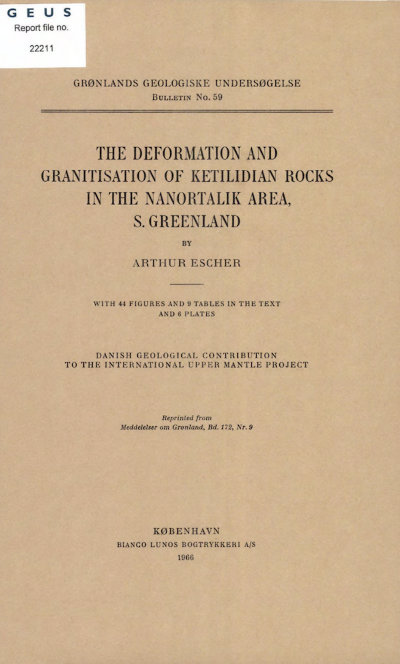The deformation and granitisation of Ketilidian rocks in the Nanortalik area, S. Greenland
DOI:
https://doi.org/10.34194/bullggu.v59.6593Abstract
The Nanortalik peninsula, situated between the fjords of Tasermiut and Sarqâ, is largely composed of Ketilidian schists, quartzites and volcanic rocks. All these rocks are more or less strongly folded. The folding took place probably in three successive phases during the Ketilidian period : A first deformation resulting in folds with NNE trending axes, was followed by a second major phase of folding with NW axes. This second folding was essentially plastic. A third deformation, acting probably on a more rigid mass, was characterised by the formation of fracturec1eavage. Third-period folds possess very long wavelengths; their axes are oriented NNE to NE. Migmatisation started probably during the second deformation period resulting in the formation of many dykes and veins of pegmatite and aplite. Four generations of Ketilidian pegmatites can be recognised. Most of them appear to have been formed by metasomatic replacement. It seems that during the Ketilidian orogeny, the evolution of the schists and gneissic schists tended to a granodioritic composition. Potassium metasomatism only became active at the end of the Ketilidian period. In the NE part of the Nanortalik peninsula, three Sanerutian granites can be observed. These granites are similar in composition (quartz-microline-biotite), but possess different ages and textures. The time interval between the last Ketilidian deformation and the emplacement of the first Sanerutian granite was marked by the intrusion of several metadoleritic dykes. The first and principal Sanerutian granite usually shows an indistinct foliation due to numerous oriented inc1usions. Field evidence indicates that this granite was formed mainly by replacement of volcanic rocks. Chemical analyses show that large amounts of K, Si and Na have been supplied to produce the granitisation of the volcanic rocks. The second Sanerutian granite is characterised by a coarse porphyroblastic texture and appears to have been emplaced partially by the intrusion of a melt and partially by a subsequent replacement of the host-rock. Finally, the last Sanerutian granite displays all the characteristics of a pure intrusive body. It is generally very fine-grained and forms many cross-cutting dykes.
Downloads
Published
Issue
Section
License
This article is distributed under a CC-BY 4.0 licence, permitting free redistribution and reproduction for any purpose, even commercial, provided proper citation of the original work. Author(s) retain copyright over the article contents.


